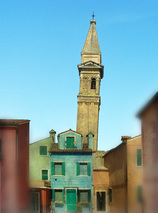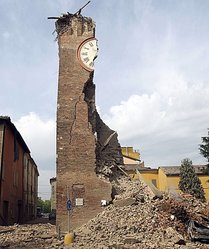|
Reaching to the heavens in Italy often manifested itself in the design and construction of free standing bell towers, defensive towers and privately owned towers built by successful merchants and aristocrats as a sign of their status and a protective measure in times of siege. The bell towers are known as campanili. But some perhaps reached too high and built on sandy and clay soils or in areas frequented by earthquake. This resulted in some towers leaning, and even collapsing entirely (many were lost this way). Still, many are still with us... as the uber-famous Leaning Tower of Pisa. But there are other leaning towers in Italy...  The Island of Burano, in the Venetian lagoon, is a contrast from the drab colors of Venice, having multicolored houses. The kaleidescope of colors is this island's main appeal, but it also has a leaning tower, the bell tower of the 15th century San Martino Church. The island is also known for lace making.  The Torre delle Milizie --Tower of the Militia--is a medieval tower in Rome located near Trajan's Market in the Imperial Forum. It is said to have been built between 1198 and 1216. An important medieval monument in Rome, the Torre delle Milizie measures 10.5 × 9.5 m at its base. The original height of the tower is unsure (it was taller when originally built), but following an earthquake in 1348, the top floors were removed as a safety measure, reducing the structure to the current height of 160 ft. The 1348 earthquake also resulted in the slight tilting of the structure to make it one of the many leaning towers of Italy.  Built in 1536 by Greek Orthodox refugees fleeing from Turkey during the rise of the Ottoman Empire, San Giorgio dei Greci has thin white bell tower. The tower was built in 1603 but it began to sink into the Venice lagoon from day one and still today has an pretty serious lean toward the canal.  Between the 12th and the 13th century, Bologna had as many as 180 towers but less than 20 are still standing today. Two of the most interesting are simply called the Two Towers, the taller named Asinelli is 318 feet tall and the shorter one called the Garisenda is 157 feet tall. They have become the symbol of Bologna. Both built in the early 1100s, Garisenda leans much more than Asinelli but being so close together, the effect of leaning is enhanced.  The imposing Church of San Pietro, was established in the 7th century. It has an obviously leaning bell tower (built by Codussi in 1482), and was the Cathedral of Venice from its origins in eighth century.The present building was built at the end of the 16th and in the first three decades of the 17th century. It contains the Throne of St Peter, a 13th century seat cut from a funeral stone and inscribed with words from the Koran.  Built in the 1100s, The Church of San Michele degli Scalzi in Pisa has a Lombard Romanesque bell tower measuring 75 feet tall. The city of Pisa is built on soil that is barely above sea level and is composed of an unstable sand-clay mix which caused not only the famous Leaning Tower to lean, but also San Michele deglie Scalzi's tower to lean toward the River Arno.  The late Renaissance bell tower of San Stefano in Venice, built in 1544, is tilted more than 7 feet from vertical. Its leaning is caused by problems in cellars under the tower - the original wooden pilings are in bad condition, and it was built on sandy lagoon sediments. Hopefully this beautiful bell tower will not follow the fate of the original St. Mark's Campanile which collapsed in 1902.  North of Lake Trasimeno in Perugia outside of the town of Vernazzano is a unique leaning tower. This tower is a remnant of an ancient castle built before 1089. Vernazzano was an important defensive unit along the ancient road that led from Perugia to Cortona and was inhabited from the 13th to the 16th centuries. It was abandoned by the 18th century when rocky mountain under it moved after a strong earthquake. This leaning tower is frequented by hikers, Driving to Vernazzano, parking and walking along a wooded path to the dangerously leaning tower. This tower is being held up by an installation of steel girders and cables.  The Cathedral of Modena boasts its own tilting tower known as Ghirlandina, taking its name from the two rows of garland-like balustrades which crown it. It is viewed by the people of Modena as the symbol of their city. Ghirlandina did not only have the religious function deriving from its status as cathedral tower, but was also a defensive tower used to store important civic documents and charters. It reaches upward next to the cathedral nearly 290 feet tall. It is a combination of two architectural styles: the original square base is in Romanesque style, while the octagonal and pyramidal upper parts are Gothic. Work on the upper part began in 1261 and was completed in 1319.  Dating from the 11th century, the Campanile of the Cathedral of Santo Stefano in Caorle, just east of Venice, is a wonderful example of Romanesque style of architecture. It stands a proud 148 feet tall and sports a conical spire above its cylindrical shape. It was more than likely built as a watchtower or lighthouse for this small port town before becoming a bell tower. The tower is tilted nearly 1.4 ° east-Southeast, around about 1/3 the lean of Pisa's famous tower. Do Leaning Towers Ever Fall? In a word--Yes. As far as we know, Venice’s famous St. Mark’s Campanile wasn't even leaning before it collapsed. During its 500 years it had been repeatedly struck by lightning, burned and damaged in several earthquakes. It might have been best to scrap the whole thing and start over after having suffered so much damage. Instead, they simply rebuilt the damaged parts, occasionally adding more height (and more weight) to the tower that was originally constructed sometime between 1148 and 1157. That wasn’t the greatest idea, given that the tower’s foundation consists of no more than vertical oak pilings driven into a bed of clay in the lagoon, then filled in with sand.  It took 10 years and $88,000 to rebuild St. Mark's tower. It took 10 years and $88,000 to rebuild St. Mark's tower. It’s no big surprise that the tower finally collapsed on July 14th, 1902. A large crack formed in the morning, rising diagonally across the main corner buttress. Falling stones within the bell chamber prevented any fatalities by warning bystanders that something was amiss. A new tower, with a much sturdier iron foundation, was built in the lost tower’s image. That is the tower we see today.  Many other towers have also fallen throughout Italy's history. In a country so geologically active, it's inevitable. For example, in 2012, the 13th century Torre dei Modenesi in the town of Finale Emilia (the name is rather foreboding), was partially collapsed by an earthquake that also killed six people. Following an aftershock, it collapsed completely. In keeping with the Italian spirit, it proudly stands today, rebuilt by its stubborn residents.  Some collapsed towers aren't meant to be rebuilt, it seems. Such is the case with the Torre Civica of Pavia which collapsed without warning in 1989. The reason for its collapse is still not known--perhaps the reason it hasn't been rebuilt. So, the next time you're in Italy and want to climb one of these towers, you might want to pause and imagine what it would feel like if even a small earthquake shook underneath your tower... Perhaps carry along a travel-parachute? And if you're in Bologna and stop dead in your tracks, gasp and look up at the leaning Twin Towers, just make sure you're not standing in the direction of their lean... --Jerry Finzi Copyright, 2017 Jerry Finzi/Grand Voyage Italy, All rights reserved
0 Comments
Your comment will be posted after it is approved.
Leave a Reply. |
Categories
All
Archive
June 2024
|




 RSS Feed
RSS Feed
